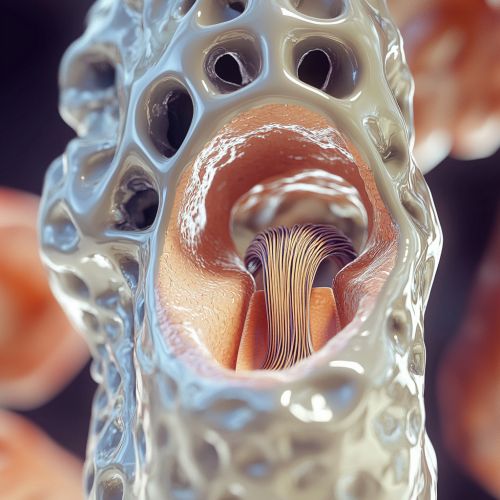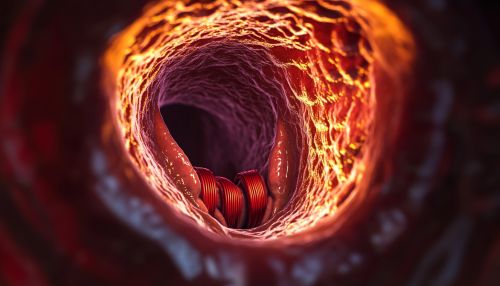Laryngeal Paralysis: Difference between revisions
(Created page with "== Laryngeal Paralysis == Laryngeal paralysis is a medical condition characterized by the loss of normal function of the larynx, commonly referred to as the voice box. This condition can affect the ability to speak, breathe, and swallow, and it can occur in both humans and animals. The paralysis can be unilateral (affecting one side) or bilateral (affecting both sides) and can result from a variety of causes, including nerve damage, trauma, or underlying medical con...") |
No edit summary |
||
| Line 3: | Line 3: | ||
Laryngeal paralysis is a medical condition characterized by the loss of normal function of the [[larynx]], commonly referred to as the voice box. This condition can affect the ability to speak, breathe, and swallow, and it can occur in both humans and animals. The paralysis can be unilateral (affecting one side) or bilateral (affecting both sides) and can result from a variety of causes, including nerve damage, trauma, or underlying medical conditions. | Laryngeal paralysis is a medical condition characterized by the loss of normal function of the [[larynx]], commonly referred to as the voice box. This condition can affect the ability to speak, breathe, and swallow, and it can occur in both humans and animals. The paralysis can be unilateral (affecting one side) or bilateral (affecting both sides) and can result from a variety of causes, including nerve damage, trauma, or underlying medical conditions. | ||
[[Image:Detail-98033.jpg|thumb|center|Close-up image of a larynx showing vocal cords and surrounding structures.|class=only_on_mobile]] | |||
[[Image:Detail-98034.jpg|thumb|center|Close-up image of a larynx showing vocal cords and surrounding structures.|class=only_on_desktop]] | |||
=== Anatomy and Physiology of the Larynx === | === Anatomy and Physiology of the Larynx === | ||
Latest revision as of 11:00, 20 September 2024
Laryngeal Paralysis
Laryngeal paralysis is a medical condition characterized by the loss of normal function of the larynx, commonly referred to as the voice box. This condition can affect the ability to speak, breathe, and swallow, and it can occur in both humans and animals. The paralysis can be unilateral (affecting one side) or bilateral (affecting both sides) and can result from a variety of causes, including nerve damage, trauma, or underlying medical conditions.


Anatomy and Physiology of the Larynx
The larynx is an essential structure located in the neck, playing a crucial role in breathing, phonation, and protecting the trachea against food aspiration. It is composed of cartilage, muscles, and ligaments, and is lined with a mucous membrane. The primary cartilages include the thyroid, cricoid, and arytenoid cartilages. The vocal cords, or vocal folds, are situated within the larynx and are responsible for sound production.
The recurrent laryngeal nerve (RLN), a branch of the vagus nerve, innervates most of the intrinsic muscles of the larynx, including the posterior cricoarytenoid muscle, which is the sole abductor of the vocal cords. Proper functioning of these nerves and muscles is essential for normal vocal cord movement and airway protection.
Etiology
Laryngeal paralysis can be caused by a variety of factors, including:
- **Neurological Disorders**: Conditions such as vagus nerve damage, amyotrophic lateral sclerosis (ALS), and multiple sclerosis (MS) can lead to laryngeal paralysis.
- **Trauma**: Surgical procedures, particularly thyroidectomy or cervical spine surgery, can inadvertently damage the recurrent laryngeal nerve.
- **Tumors**: Neoplasms in the neck or chest, such as thyroid or lung cancer, can compress or invade the recurrent laryngeal nerve.
- **Inflammatory Conditions**: Infections or inflammatory diseases like rheumatoid arthritis can affect the laryngeal nerves.
- **Idiopathic**: In some cases, the cause of laryngeal paralysis remains unknown.
Clinical Presentation
The symptoms of laryngeal paralysis vary depending on whether the condition is unilateral or bilateral:
- **Unilateral Paralysis**: Patients may experience hoarseness, breathy voice, and mild dysphagia. The affected vocal cord remains in a paramedian position, leading to incomplete glottic closure during phonation.
- **Bilateral Paralysis**: This condition is more severe and can cause stridor, dyspnea, and significant difficulty in breathing. Both vocal cords may remain in a median or paramedian position, leading to a compromised airway.
Diagnosis
The diagnosis of laryngeal paralysis involves a thorough clinical evaluation, including:
- **History and Physical Examination**: A detailed medical history and examination of the neck and larynx.
- **Laryngoscopy**: Direct visualization of the vocal cords using a flexible or rigid laryngoscope to assess their movement.
- **Electromyography (EMG)**: This test measures the electrical activity of the laryngeal muscles to evaluate nerve function.
- **Imaging Studies**: CT or MRI scans may be performed to identify underlying causes such as tumors or structural abnormalities.
Treatment
The treatment of laryngeal paralysis depends on the underlying cause, severity of symptoms, and whether the condition is unilateral or bilateral:
- **Voice Therapy**: Speech-language pathologists can provide exercises to improve vocal function and compensate for vocal cord weakness.
- **Surgical Interventions**:
* **Medialization Thyroplasty**: This procedure involves placing an implant to push the paralyzed vocal cord towards the midline, improving voice quality and airway protection. * **Arytenoid Adduction**: This surgery repositions the arytenoid cartilage to improve glottic closure. * **Reinnervation Techniques**: Nerve grafts or muscle-nerve pedicle transplants can restore nerve supply to the paralyzed vocal cord.
- **Tracheostomy**: In severe cases of bilateral paralysis with significant airway obstruction, a tracheostomy may be necessary to secure the airway.
Prognosis
The prognosis of laryngeal paralysis varies based on the underlying cause and the effectiveness of treatment. Some patients may experience spontaneous recovery, particularly if the paralysis is due to temporary nerve injury. Others may require long-term management and follow-up to address persistent symptoms and prevent complications.
Complications
Complications of laryngeal paralysis can include:
- **Aspiration Pneumonia**: Due to impaired airway protection, patients are at risk of aspirating food or liquids into the lungs.
- **Chronic Respiratory Issues**: Persistent airway obstruction can lead to chronic respiratory problems and reduced quality of life.
- **Voice Disorders**: Ongoing vocal cord dysfunction can result in chronic hoarseness and voice fatigue.
Research and Future Directions
Ongoing research in the field of laryngeal paralysis focuses on improving diagnostic techniques, developing advanced surgical methods, and exploring novel therapeutic approaches such as stem cell therapy and gene therapy. Advances in understanding the molecular mechanisms underlying nerve injury and regeneration hold promise for future treatments.
